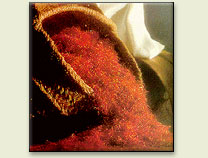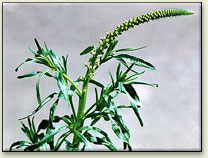Raw material for the dye of robes of Chinese Emperors is the crocus-like saffron plant. During autumn saffron bears pale violet flowers equiped with a four inches long style with three threadlike filaments. Collecting 8000 saffron flowers bring about 100 g of dried brownish red filaments, from which the yellow dye crocin can be extracted. Crocus of ancient times was regarded as the King of the Plants based on the incredible dyeing power of its dye. The color of the dye can be percieved in dilutions up to the ratio of 1 : 200 000. Saffron was used to color cosmetics, wine, foods (e.g. rice) and also as a spice. Roman emperor used it to perfume his bath and the rich people’s seats in theater were sprinkled with saffron wine. It was also known for its disinfecting and even healing effects. Saffron dyed mummy bandages document the use of saffron in Ancient Egypt. Luteolin, the less expensive substitute for saffron could be extracted from weld (Reseda luteola).
Daughters of European royal families were frequently seen wearing saffron dyed silk gowns as a symbol of superiority. Only the expensive silk of pure white color was suitable for dyeing with saffron, cotton and other inferior textiles would get an unsightly greyish tint. Saffron was reputed to be the color of love and later also of lust. Venus, the Roman Goddess of love wore an yellow robe. These aspects of yellow led to a change of its connotation in medieval Christianity and it became the color of prostitutes, who were forced to make themselves recognizable by wearing an yellow ribbon, belt or cape. The next step in the downfall of this color was based on the fact, that yellow was easily sullied by other colors. Greenish-yellow started to be associated with repulsion, pus and leprosy. Yellow flag designated areas of raging plague. The robe of the traitor Judas is yellow in the fresco "Judas’ Kiss" by Giotto di Bondone (1267-1337).
The reason for all Evil was believed to be the gall and a yellowish complexion denoted anger, eternal envy, jealousy and also stinginess. Stinginess and Envy were two of the seven mortal sins in Christianity, which led to even stronger negative connotation of yellow.
Use of this color to express contempt and to ostracise and discriminate human beings culminated in labeling of Jews in fascist Germany during WWII by the yellow Star of David. The prosecution of Jews by Christians is much older, however. Jews were obliged to wear an yellow hat as early as in the 12th century.
(main yellows page) - Naples yellow - Orpiment - lead tin yellow - Orpiment - cadmium yellow - chrome yellow - - Yellow ochre - Cobalt yellow - Indian yellow - Lemon yellow




